The xiphoid process is the smallest bone structure located at the end of the long cancellous bone of the sternum (photo presented on the website) and is part of the axial skeleton. The name comes from the Greek word for "straight sword" as the structure resembles the sharp tip of a sword.
Record content:
- 1 Functions
- 2 Structure
- 3 Types of diseases
- 4 Symptoms
- 5 The causes of organ diseases
- 6 Diagnostics
- 7 When to see a doctor
- 8 Prevention
-
9 Treatment methods
- 9.1 Medications
- 9.2 Traditional methods
- 9.3 Other methods
- 10 Possible complications
- 11 Chest Anatomy Videos
Functions
The xiphoid process serves as a vital attachment point for several major muscles. These are the muscles of the diaphragm, rectus and transverse abdominal muscles. During cardiopulmonary resuscitation, the xiphoid process is used as a bony guide to locate chest compression.
It is extremely important that during compression of the chest there is no pressure on the process, as this can lead to its separation from the sternum and puncture of the diaphragm or liver.
A small process also serves as a guide when determining:
- distal edge of the heart;
- the upper end of the liver;
- central tendon of the diaphragm;
- distal, anterior edge of the chest;
- the angle between the lower borders of the costal cartilage.
Structure
The ribs form the basis of the rib cage, the front ends of which are connected to the sternum, and the rear ends to the thoracic vertebrae. The most important human organs are located in the chest cavity: lungs, heart, nerves and large blood vessels.
A long tubular bone - the sternum - closes the front of the chest. It consists of three parts: the body, the handle and the xiphoid process.
The xiphoid process of the sternum (photographs of its various forms can be seen on medical sites) begins its development from hyaline cartilage. While developing, it slowly turns into the bony part of the sternum. For many people, it differs in shape: it can be wide and thin, pointed, bifurcated, perforated, curved or significantly deflected to one side or the other.
The most common shape resembles a triangle; some people often have a hole in the center of the appendix. Ossification of this part of the sternum is slow. In infants, the process is cartilage that can be felt just below the sternum.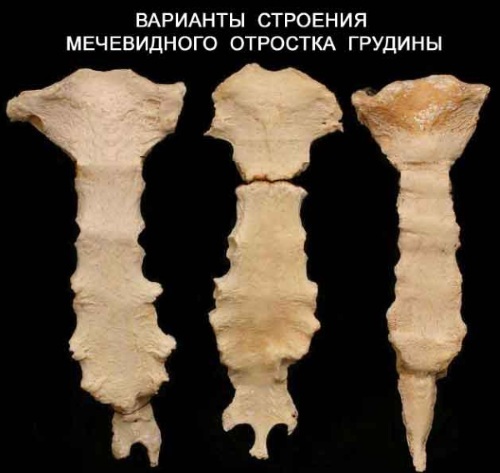
Over the next 30 years, the xiphoid process gradually connects to the sternum through the fibrous joint and becomes ossified. In youth, the xiphoid process rarely causes any discomfort, since the structure of the cartilage is soft. The inferior process can be felt through the skin.
Types of diseases
The xiphoid process of the sternum (photo presented in this article) sometimes causes pain when pressed.
This may be due to developing diseases in nearby organs:
- in the stomach;
- a heart;
- gallbladder;
- pancreas;
- lungs.
Often there are pains caused by disorders of the musculoskeletal system:
- Hernia of the xiphoid process. It manifests itself after injury and often depends on the shape of the appendix. Normally, it has several holes, closed by a fibrous plate. In its absence, adipose tissue penetrates from nearby organs through the openings of the appendix. Thus, a preperitoneal lipoma is formed. On palpation, the hard edge of the hernia and the contents of its sac are felt.
-
Tietze's syndrome. The disease is associated with an inflammatory process that occurs in the cartilage tissue. The pain is felt at the junction of the upper ribs and bones of the chest, it is given to the area of the xiphoid process. The syndrome develops due to a lack of calcium, metabolic disorders, age-related changes.
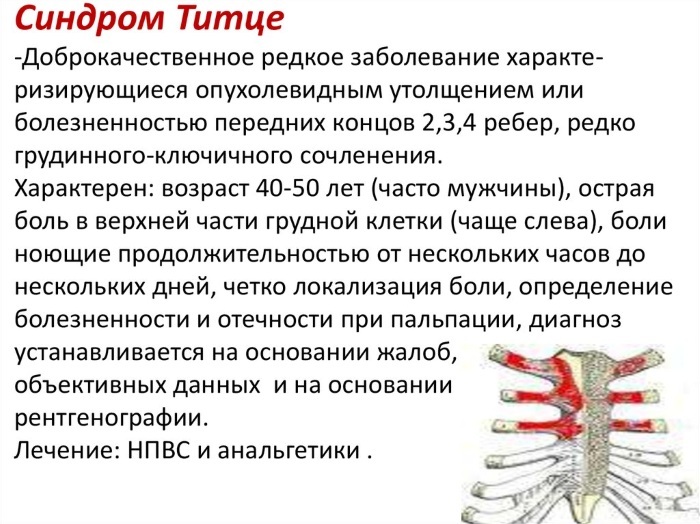
- Sliding rib syndrome. Recurrent subluxation of the cartilage leads to excessive mobility, slipping of the rib. The bone then touches the nerve, causing pain.
- Chest osteochondrosis. Hernias in the intervertebral zone, protrusions lead to the fact that the tissues lose their elasticity, while squeezing the nerve fibers. The pain that develops in this area also affects the process.
Diseases of the internal organs located in the peritoneum cause pain not only in these organs, but are also reflected in the xiphoid process. In this case, the pain intensifies when pressing on the appendix.
These include:
- pancreatitis;
- stomach ulcer;
- diseases of the esophagus;
- gastritis.
Pain in the appendix with disorders of the digestive system often occurs when changing the position of the body, while eating.
Symptoms
The main characteristics of the xiphoid syndrome are intense, sharp pain in the xiphoid process when pressed, increased pain when bending or twisting, pain when touched. The pain usually starts suddenly and can last for weeks or months, but in most cases it goes away spontaneously.
Other symptoms may appear:
- chest pain, back, shoulder;
- pain in the epigastric region:
- nausea;
- vomit;
- chest discomfort;
- diarrhea.
With muscle rupture, fractures and bruises of the chest, there is a sharp pain in the process region. The intensity increases with movement, breathing, sharp turns. After injury, pain persists for a long time.
The causes of organ diseases
The most common causes of pain in and around the appendix are physical trauma, gastroesophageal reflux disease (GERD).
Physical trauma results in a swollen, inflamed, or fractured xiphoid process. Although the bone is quite small, in the event of a fracture, it can break away from the sternum and move down to the diaphragm and even the heart. Injuries and fractures can also occur during cardiac resuscitation.
GERD usually occurs when stomach acid backs up into the esophagus because the muscle valve at the end of the esophagus does not close properly. This irritates the mucous membranes and causes reflux. The esophagus is located behind the breathing tube (trachea), which runs just behind the sternum. The proximity of these structures contributes to the spread of pain in the process area.
The xiphoid process of the sternum (photo attached) may take on a protruding, protruding appearance. Bulging is uncommon and common in people who have lost a significant amount of weight. Some do not feel any pain, while others feel sore and swollen.
Trauma is a common cause of bulging, but visceral fat is a more likely cause. In obese people, this fat puts additional pressure on the internal organs and the chest itself, causing them to expand.
Since the xiphoid process has a cartilaginous structure, it can easily budge and bulge. With constant weight loss, the appendage becomes more and more visible.
Pain in the bone structure can be caused by inflammatory processes that accompany disorders:
- chondropathy;
- hernia;
- osteochondrosis.
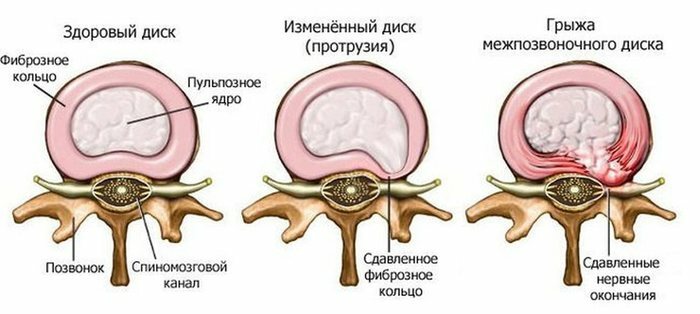
Other causes include respiratory diseases: tuberculosis, bronchitis, pneumonia. Against the background of cardiac disorders, pain in the appendix may occur, in particular, with angina pectoris.
Diagnostics
Chest pain is diagnosed by history and physical examination. First, the doctor determines if the pain in the sternum belongs to the heart. In this case, immediate intervention and treatment is required.
Research is being conducted:
- electrocardiogram, the cost of the procedure is from 1 thousand. 200 rubles;
- chest x-ray, cost from 500 rubles;
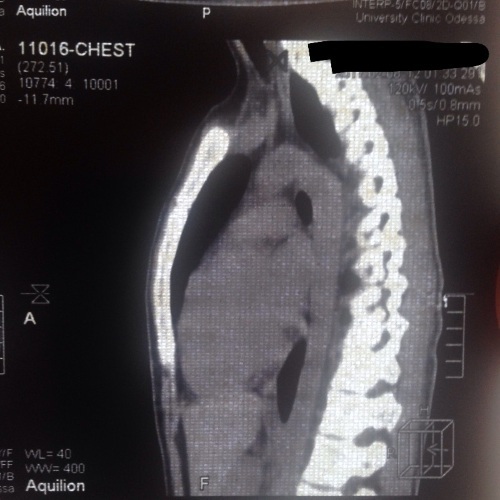
- determination of the level of troponin in the blood, increased may indicate damage to the heart muscle, cost: from 1 thousand rub.;
- blood tests, such as a general and basic metabolic panel, cost from 600 rubles.
Coronary artery disease is detected by coronary angiography, which is used to detect atherosclerosis.
Further examination is carried out using the procedures necessary, according to the doctor:
- MRI of the thoracic spine, the cost of the procedure is from 4 thousand. rub.;
- gastroscopy, assessment of the state of the mucous membrane of the stomach and duodenum, esophagus, the cost of the procedure from 3 thousand. rub.
When to see a doctor
The sternum, causing pain in the xiphoid process, should not be overlooked. To find out the cause of the onset of pain, you should contact a therapist. After the test results are obtained, the doctor can refer you for consultation to other specialists: traumatologist, gastroenterologist, surgeon. This will require X-ray photographs of the appendix.
Prevention
Preventive measures are specific and general.
The first preventive measures include:
- maintenance drugs;
- elimination of heavy loads;
- adherence to a diet;
- overstrain of the muscles of the chest.
General rules of prevention:
- a healthy diet that includes foods containing fiber, avoiding foods high in fat;
- quitting bad habits, especially smoking;
- elimination of stress;
- observance of the correct alternation of work and rest, including good sleep;
- maintaining health through exercise.
Treatment methods
Damage to the xiphoid process is not serious in itself. There is no single right solution for xiphoid pain. It will largely depend on the cause and condition that is causing the pain.
To relieve pain, analgesics are offered. In more severe cases, when analgesics do not work, steroid injections are used.
The main therapeutic measures:
| Tietze syndrome | Warming procedures, taking NSAIDs, in case of severe pain, a local anesthetic - novocaine solution is used, sometimes in conjunction with a corticosteroid |
| Sliding hip syndrome | NSAIDs, anesthetic blockade, in rare cases, rib edge resection |
| Costo-sternum syndrome | Intercostal nerve blockade |
Applying heat and ice helps relieve pain and swelling. Diet changes and light exercise will help with gastroesophageal reflux, and surgery may be necessary if there is any anatomical abnormality.
Medications
Pharmacotherapy should be determined individually for each patient, taking into account the clinical picture. For persistent pain, non-steroidal anti-inflammatory drugs, local novocaine blockade are used. For treatment, topically applied ointments, gels containing NSAIDs.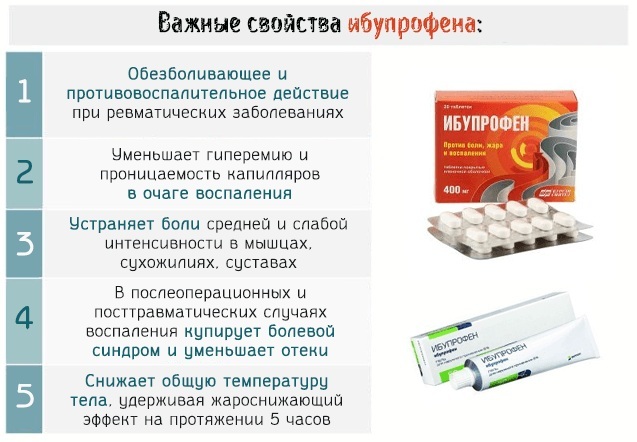
| Group of drugs | Name | Indications for use | Price in rub. |
| Anti-inflammatory | Diclofenac | It is taken orally, without chewing, for 30 minutes. before meals, with plenty of water, 25-50 mg, maximum 150 mg per day, dividing the dose into 2-3 doses | 20 |
| Ibuprofen | For moderate pain, 1200 mg per day is taken, for injuries 1600-2400 mg, one time, at night | 25–35 | |
| Movalis | Dose from 14 to 15 mg, taken 1 time per day, before meals | 500 | |
| Ortofen | 1-2 tablets 2-3 times a day, but not more than 6 tablets. in a day | 35–45 | |
| Muscle relaxants | Mydocalm | 1 tablet Up to 3 times a day, after meals | 300 |
| Pain relievers | Ketanov | A single dose - 10 mg, if necessary, you can take up to 4 times a day, but not more than 40 mg | 55 |
| Baralgin | Single dose of 500 mg, 1 tab. Maximum -2 tab. Per day | 160–240 | |
| Ointments and gels | Ortofen | Apply in a thin layer, no more than 2-4 g, 3 times a day | 130 |
| Ibuprofen Verte | Apply 3-4 times a day, rubbing lightly into the skin | 90 | |
| Dolgit | 5-10 cm of the drug is applied to the skin 3-4 times a day, rubbed until completely absorbed | 90 |
If the cause of pain is associated with a disorder of the digestive tract, heart, lungs, the doctor will prescribe appropriate therapy. Acid reflux irritation is treated with antacids, a special diet.
Traditional methods
The xiphoid process of the sternum (a photograph of the bone anatomy is presented) causing discomfort can be treated with folk remedies. Before using any natural herb, you should make sure that the condition is correctly diagnosed and that the pain is not caused by pulmonary complications or heart attack.
Compresses help relieve pain, inflammation:
- Dissolve 1 tsp. l. salt in 1 glass of water. Moisten a gauze pad in the solution, put in a plastic bag and remove for 2-3 minutes. into the freezer. Apply the frozen gauze to the process area and leave to dry.
- Grind 300 g of garlic, pour 250 ml of alcohol. Insist the solution in a dark place for 10 days. With the help of the ready-made solution, a compress is made on the sternum area. The moistened gauze is applied to the skin, covered with cellophane on top and wrapped in a warm scarf. The bandage is kept for 1–1.5 hours.

- Smilax root contains steroid saponins and is used as a pain reliever. The broth is prepared from 1 tsp. l. ginger root and 1 tsp. l. smilax root. The mixture is poured with 1 glass of boiling water. Infused for 20 minutes. The prepared drink is consumed 2 times a day instead of tea.
Ginger is effective for acid reflux:
- Add 1 tbsp. l. chopped root 250 ml of hot water. Let stand for at least 30 minutes.
- Drink during the day instead of tea.
Warming compresses are good for pain.
Other methods
In the case of rehabilitation after injuries, motor activity should be restored gradually, avoiding sudden movements.
Sessions are assigned:
- Physiotherapy. The procedures restore peripheral and central blood circulation, relieve pain. The type of treatment prescribed will depend on the source of the pain. Physical therapy can help relieve pain in the muscles attached to the xiphoid process. In case of rib fractures, physiotherapy is not prescribed.
- Reflexology. With its help, blood circulation improves, the restoration of cartilaginous tissues. UHF. Electromagnetic fields help healing after fractures, reduce swelling, pain, and inflammation.
- Irradiation with a Sollux lamp.

- Chest massage.
The effect of therapeutic actions depends on the patient's efforts to perform a set of physical exercises. They should strengthen the muscle corset, relieve muscle tension.
If during the diagnosis a hernia, sliding rib syndrome was detected, then an operation is proposed.
Possible complications
Since pain in the xiphoid process is a syndrome, it can accompany various diseases. A timely unknown etiology can lead to a number of complications in the cardiac, digestive, and respiratory systems.
Pain in the xiphoid process, if not caused by injury, is often a warning sign. Do not ignore it, as it may indicate a developing internal disease. A timely examination, primarily a photo taken with an X-ray, will help to identify the cause of the appearance of pain in the sternum.
Article design: Vladimir the Great
Chest Anatomy Videos
Chest Anatomy:
